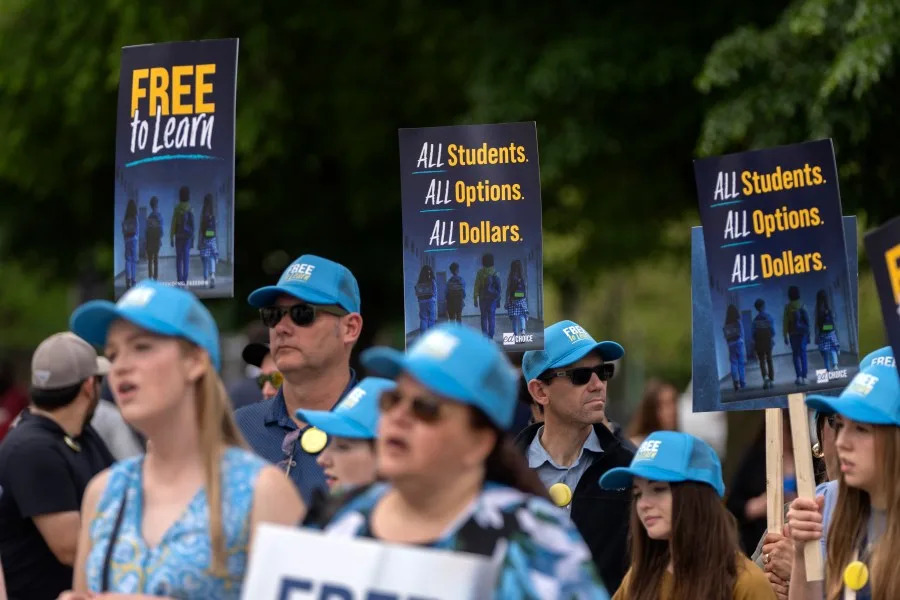
Texas no longer allows certain undocumented students to pay in-state tuition following demands from the Trump administration to end the policy.
Soon after the federal government sued Texas in June over a state law allowing the practice, Texas quickly asked the court to side with the feds and deem the law unconstitutional. U.S. District Judge Reed O’Connor’s ruling did just that and immediately blocked the law.
The Texas Higher Education Coordinating Board instructed schools to adjust tuition for undocumented students starting this fall but did not provide further guidance.
Advocates for students say the rollout of the changes has been inconsistent. Some students have received little to no guidance from colleges, and others have been incorrectly reclassified as out-of-state students because of differing interpretations of the ruling.
“It’s a really tricky situation that the schools and the students and those who work with them or care about them are trying to navigate,” said Will Davies, director of policy and research for Breakthrough Central Texas, an organization that helps first-generation college students.
Advocates urge students to press their universities or colleges for more information and to stay informed, especially since some students — like those with visas or shielded from deportation — could still qualify for in-state tuition.
This is what we know about the ruling and its implications. This story will be updated as more information becomes available.
Who does this affect?
Under the 2001 Texas Dream Act, Texas university and community college applicants who lived in the state three years before graduating from high school (or receiving an equivalent diploma) could seek in-state tuition, even if they were not permanent residents or U.S. citizens. To qualify, those students had to sign an affidavit stating that they would apply to become a permanent U.S. resident as soon as they were able.
More than 18,500 students in the state signed this affidavit in 2024, according to the Texas Higher Education Coordinating Board. This figure, however, includes not only undocumented students but also students with visas allowing them to legally accompany family members who have been approved to work in the U.S., according to state data.
O’Connor’s ruling specifically blocks the Texas law “as applied to aliens who are not lawfully present in the United States.” That means some immigrant students, such as visa holders and immigrants protected from deportation under the Deferred Action for Childhood Arrivals, or DACA, program, still qualify for in-state tuition.
In lawsuit filings over the policy change, attorneys representing Texas have acknowledged that DACA recipients still qualify for in-state tuition.
[Texas universities could see fewer international students amid immigration crackdown, reports say]
The Texas Immigration Law Council has a list of people who may qualify as lawfully present, including those with Temporary Protected Status or with pending immigration adjustment applications.
Because the Texas Dream Act didn’t require institutions to track a student’s immigration presence or status, it has been unclear how many affidavit signers are undocumented students or how colleges would determine which students no longer qualify for in-state tuition. Kristin Etter, director of policy and legal services for the Texas Immigration Law Council, worries students who are not well-informed could be “wrongfully denied” in-state tuition.
When does this go into effect? Can this be appealed?
The federal ruling blocked the law immediately. The ruling was final. Since Texas asked the court to side with the federal government and deem the law unconstitutional, it is not expected that the state to appeal.
A group of undocumented students, Austin Community College and the group La Unión Del Pueblo Entero, asked Judge O’Connor to let them intervene in the case with hopes of overturning the ruling. He rejected their request on Aug. 15, saying they sought intervention too late and lacked the legal authority to defend the law.
They have appealed to the 5th U.S. Circuit Court of Appeals.
“The 5th Circuit’s obviously a very conservative court, but part of that conservatism is a pretty limited view of the role the courts should play in legislation,” said David Coale, a Dallas appellate lawyer. “It’s a tricky case for them to review.”
How are Texas colleges and universities responding to the ruling?
Since the state has not yet provided much guidance to schools on how to implement the changes, universities and colleges have had to interpret the order on their own, said Will Davies, director of policy and research for Breakthrough Central Texas. That has also placed the burden of identifying, tracking and reclassifying students on schools, he said.
“We've got schools being forced into managing the fallout of a really rushed implementation without consistent standards, training, any real clarity from state agencies,” Davies said.
Some institutions like the University of Texas at Austin have requested that students submit proof of legal status, a higher bar that could prevent lawfully present immigrants like DACA recipients from paying in-state tuition rates.
Section 54.009 of the Texas Education Code says schools can’t raise tuition bills once students have registered for classes for that semester. The Texas Immigration Law Council recommends that students who saw their fall tuition increase but had already registered for classes and been billed for the fall semester advocate for themselves by citing this consumer protection law.
[Undocumented students rethink their college dreams after Texas cuts their access to cheaper tuition]
This month, The Texas Tribune asked the six four-year universities and three community college districts with the most affidavit signers how they’re determining who no longer qualifies for in-state tuition, how they’re informing students about their decisions, and how they’re supporting and protecting students during this process. They were the University of Texas-Rio Grande Valley, UT-Dallas, UT-Arlington, UT-Austin, Texas A&M, University of Houston, Dallas College District, Lone Star College District and Houston Community College.
Most of the schools did not respond. UT-Dallas directed the Tribune to a page on its website, which stated on Aug. 21 that the university had a residency review team that was processing documents students submitted between July 30 and Aug. 6.
A spokesperson for the Texas A&M University System said officials were accepting the same documents the Texas Department of Public Safety accepts to establish lawful presence and would continue to do so until Sept. 8.
A UT-RGV spokesperson declined to answer specific questions about the university’s process and reiterated its comments after the court ruling in June.
“Our priority and focus are on minimizing disruption to student success consistent with applicable law and helping students navigate this transition with clarity and care,” the spokesperson said in a statement.
What can students do?
If a school doesn’t have a designated team to help students affected by tuition changes or who have been misclassified, the Texas Immigration Law Council advises them to keep calling admissions and financial aid offices at their college with their questions. If an institution is unresponsive, Etter, with Texas Immigration Law Council, suggests students try to go in person. They should also review the Texas Immigration Law Council’s FAQs and resources, she said.
“We're really trying to make schools aware that students need to be able to figure this out,” Etter said. “They need to have a designated employee that can help answer these questions and support students. Because really, at the end of the day, schools and students are left holding the bag, and they've received no guidance, no support, and they're essentially now potentially depriving thousands of students their ability to pay in-state tuition.”
Breakthrough Central Texas, which advises students who are the first in their families to pursue higher education, has been helping affected college students decide what to do. That has included helping students who are lawfully present in the country safely submit their documentation and helping those who may no longer qualify for in-state tuition consider their options.
For students providing documentation to show their lawful presence, photocopies are always advised and permissible, Davies said, noting that universities typically don’t require original documents other than transcripts. Advocates for students have created a checklist for students who need to prove lawful presence that can be found here, along with other resources.
Students who are close to completing their degree or are enrolled at more affordable colleges — where the increase from in-state to out-of-state tuition rates may not be as high — might want to explore financial options to stay in school, Davies said.
But that may not be as feasible for students at more selective institutions with higher out-of-state tuition costs or for people who are just starting with their studies. Davies said those students should consider reducing the number of credit hours or classes they take per semester, exploring lower-cost online options or transferring to another public or private institution that is more affordable.
His organization is also helping students understand which classes under their programs of study they must take at their college and which classes could be taken at a community college, online or elsewhere, Davies said.
“That's really how granular young people are needing to get in thinking about how they're going to navigate this change,” he said.
Private universities generally have a single tuition rate but costs can vary per student depending on tuition discounts and merit- or need-based scholarships. However, they are usually more expensive and selective, making them out of reach for most students, Guengerich Harper said.
Some private organizations, such as TheDream.US, provide scholarships for undocumented students, including in states where in-state tuition is not an option for them. Some groups, such as Rooted, an initiative that provides support for immigrant students at UT-Austin, have launched fundraising campaigns to help affected students.
Students Engaged in Advancing Texas and Texas Students for DEI also launched a fundraising campaign to help students cover the difference between in-state and out-of-state tuition for the fall semester. But the groups had to close applications on Aug. 11 after the volume of applications exceeded the funds they had raised.
How much more is out-of-state tuition in Texas?
How long a student has been living in Texas is one of the biggest factors in determining a student’s tuition, or coursework bill. (Tuition does not account for other college fees or housing and living costs.)
Each college sets its own tuition residency criteria, according to the THECB. Community colleges often offer lower tuition rates to people who live within their tax district.
Students from outside the state or country can, in some cases, pay almost four times more than in-state students.
At the UT-Austin, the state’s flagship university, the flat-rate tuition for the fall 2025 and spring 2026 semesters costs $15,848 more for an out-of-state liberal arts student taking 12 or more credit hours than it would for a student with similar coursework paying in-state tuition rates, according to the university. Tuition also costs $18,765 more for an out-of-state student studying business and $17,713 more for engineering.
At Lone Star College in Houston, tuition for 12 credit hours for an out-of-state or international student costs $768 more than for an in-state student, and $2,424 more than for a student who lives within the college’s tax district, according to the community college’s 2025-26 rates.
How did we get here?
Since Texas became the first state to extend in-state tuition eligibility to undocumented students in 2001, Republican state lawmakers have filed at least 15 bills trying to undo the state law.
Immigrant rights advocates worried the push to repeal the law would gain more traction during the 2025 legislative session as the Trump administration promised to ramp up immigration enforcement and Texas sought to match its pace. Earlier this year, a bill to repeal the Texas Dream Act was voted out of committee for the first time in a decade, but failed to advance any further.
Immigrant rights advocates’ relief was short-lived. They were caught off guard when the Justice Department sued Texas two days after the legislative session ended, arguing that Texas should not offer undocumented students any benefit not afforded to U.S. citizens (U.S. citizens living outside of Texas don’t qualify for in-state tuition in the state’s public universities).
The state agreed and asked the judge overseeing the case to side with the federal government, which he did and declared the law unconstitutional. Some legal experts have said the speedy way in which the case was resolved makes it seem like federal and state attorneys colluded to coordinate the outcome.
Monica Andrade, an attorney and director of state policy and legal strategy at the Presidents’ Alliance on Higher Education and Immigration, said the argument that undocumented students were receiving benefits denied to U.S. citizens is false and misleading because, under the Texas Dreamer Act, both groups of people needed to meet the same criteria to qualify for in-state tuition.
Since President Donald Trump’s election in November, several states have moved to end tuition assistance for undocumented students, Inside Higher Education reported. In February, Florida passed a law that eliminated in-state tuition for undocumented students. Lawmakers in Massachusetts and Minnesota also filed similar bills to try to restrict undocumented students from receiving state assistance for college, but the bills do not appear to have passed.
State officials in Minnesota and Kentucky also faced lawsuits from the Trump administration over tuition policies for undocumented college students. Those lawsuits are still ongoing.
Meanwhile, some states like Indiana and New Mexico have sought to expand in-state tuition eligibility.
The Trump administration and Republicans have sought to end other benefits for immigrants. In July, the Trump administration announced plans to cut undocumented immigrants’ access to a range of federally funded programs, including community health centers and the early child support program Head Start.
Texas in recent years has increasingly mirrored Trump’s aggressive immigration agenda, increasing its law enforcement presence and building its own wall along the U.S.-Mexico border.
Disclosure: Houston Community College, Lone Star College, Texas A&M University, Texas A&M University System, University of Houston, University of Texas - Rio Grande Valley and University of Texas at Austin have been financial supporters of The Texas Tribune, a nonprofit, nonpartisan news organization that is funded in part by donations from members, foundations and corporate sponsors. Financial supporters play no role in the Tribune's journalism. Find a complete list of them here.
Big news: 20 more speakers join the TribFest lineup! New additions include Margaret Spellings, former U.S. secretary of education and CEO of the Bipartisan Policy Center; Michael Curry, former presiding bishop and primate of The Episcopal Church; Beto O’Rourke, former U.S. Representative, D-El Paso; Joe Lonsdale, entrepreneur, founder and managing partner at 8VC; and Katie Phang, journalist and trial lawyer.
TribFest 2025 is presented by JPMorganChase.
Correction, Aug. 26, 2025 at 2:15 p.m. : An earlier version of this story incorrectly stated that Michigan was one of several states where lawmakers filed proposals to restrict undocumented students from receiving state assistance for college. States that filed legislation to that effect this year include Texas, Massachusetts and Minnesota, but not Michigan.






Comments